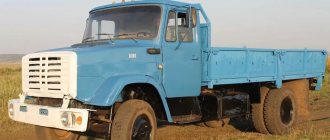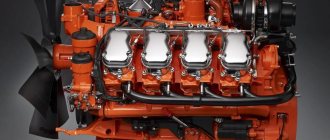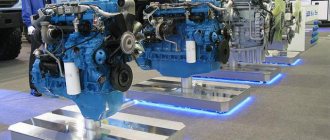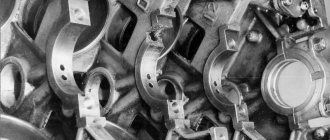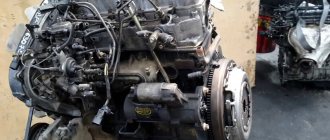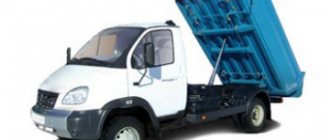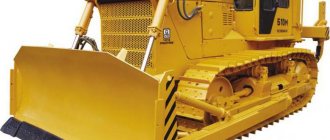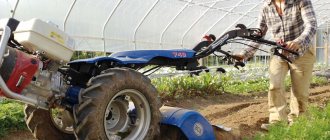GAZ-3307 is a 4th generation domestic truck, production of which began at the Gorky Automobile Plant. The launch of production of an onboard car with a carburetor engine began in 1989. The production of the truck was almost completed in 1994.
The truck updated the line of cars after the old GAZ-53, which structurally and morally required updating. It was necessary to update the technical parameters and update the appearance of the car.
History of creation
The debut model of the new car left the factory already in 1989, and by the end of the same year they were able to establish serial production of this dump truck. A little later, this vehicle was replaced by another GAZ-3309 truck, on which a diesel power unit was installed.
However, when 2008 arrived, the 3307 was able to receive a brand new carburetor engine with increased power and began production again until 2012. In general, the truck started quite successfully, but almost immediately lost popularity. Following the collapse of the Union of Soviet Socialist Republics, the car noticeably dropped in demand, and its large-scale production at the plant was discontinued.
The Gorky Automobile Plant produces specialized modifications for government agencies. Before the 3307 model, there was a GAZ-53 truck on the market. By the end of the 1980s, such a car was very outdated and needed improvement.
This prompted the designers to start designing a completely new car. The machine was adapted to operate on hard road surfaces. “Lawn” belonged to the 4th generation of GAZ cars. It also includes trucks GAZ-3309, GAZ-3306 and GAZ-4301.
One of the goals that the design staff adhered to during the design of the machine was full-scale synchronization of the main elements and components with previous models. As a result, the car received many parts from the 53rd Lawn.
Thanks to this solution, it was possible to facilitate machine maintenance and reduce production costs. Therefore, Lawn 3307 was able to surpass the 53rd model in numerous characteristics. It was decided to retain the hood layout of the truck.
The models were distinguished by the presence of an improved cabin and a new tail. The salon began to have an abundance of free space, and it was possible to add ventilation and heating. Small changes could also affect the power plant. At the plant in Gorky, the 3307 was planned as a transitional option, which could later be replaced by diesel variations with increased economic characteristics.
A little later, the plant began producing power units that ran on diesel fuel. The production of carburetor versions of the Lawn 3307 was completely stopped with the beginning of the new decade of the 1990s.
Variations with diesel engines also began to lose popularity every year, since their production was no longer profitable. Today, the Gorky Automobile Enterprise can only offer truck configurations with gasoline power units (production is carried out only on order).
Despite the fact that the basis for the "Lawn" 3307 is a special production vehicle, the structural technical characteristics provide the opportunity to transport bulky and heavy loads.
Despite the rather large overall components of the truck, the model turned out to be a fairly maneuverable vehicle, and therefore can be used in city traffic quite freely.
Moreover, GAZ can move even off-road. You can use a car in different climate conditions, which is a very important help for the Russian Federation. Thanks to its endurance, the car was able to become a popular model.
The main purpose of the "Lawn" is the transportation of various goods. Thanks to a large number of add-ons, it is possible to select the equipment required for specific tasks. On the platform, cars are released by car towers along with milk tankers, car cranes and garbage trucks. But this allows you to greatly expand the range of applications of the truck.
The vehicle is designed for transportation and quick unloading of various bulk materials. It is extremely convenient to use it for agricultural needs, because it is well able to overcome unpaved road surfaces. As long as collective farms existed, such dump trucks served as a clear sign of any machine yard.
GAZ-3307
GAZ-3307 is a fourth-generation domestic truck, produced by the Gorky Automobile Plant.
Production of the onboard carburetor truck started in 1989. Large-scale production of the model was almost completely stopped in 1994. It was replaced by the GAZ-3309 version. At the same time, the plant did not completely stop producing the car, leaving specialized modifications for government agencies in production. The company continues to export the carburetor version to the Belarusian market. GAZ-3307 became the successor to the GAZ-52/53 family, which was seriously outdated by the end of the 80s. The model completely replaced its predecessor by 1993. The truck was designed to work on paved roads. In addition to the GAZ-3307, the fourth generation of products of the Gorky Automobile Plant included the GAZ-3309, GAZ-4301 and GAZ-3306. In 1999, a “replacement” model was introduced - the GAZ-3308 "Sadko" with the function of adjusting the air pressure in the tires, in 2005 - the GAZ-33086 "Countryman".
Device
1 – chassis; 2 – platform with extension sides; 3- over-frame device; 4 – control levers PTO and CU; 5 – oil tank; 6 – mudguards; 7 – hydraulic cylinder; 8 – PTO with control valve and oil pump; 9 – platform clamps; 10 – rear light devices, 11 – side light devices, 12 – rear underrun protection; 13 – lateral protection.
Rice. 1.1. Structure of the GAZ-3307 car: / - engine; 2 — Front wheel; 3 — air cleaner; 4 - Fuel tank; 5 - Steering wheel; 6 — car frame; 7 — rear drive axle; 8— Rear spring suspension; 9 — rear wheel; 10— Vacuum brake booster; // — cardan transmission; 12 — central transmission (parking) brake; 13 - Gearbox; 14 - Clutch; 15 - Front axle; 16 — front spring suspension
The GAZ-3307, unlike its predecessor, received a sprung driver's seat with the ability to adjust the back angle and in the horizontal plane. The instrument panel turned out to be very informative and was made of plastic. The holes for the instruments were completely molded. The front panel was made of metal.
The appearance began to differ for the better when comparing the model with its predecessor, the GAZ-53. The exterior began to have a more straightforward appearance. The same bumper protruded ahead and contained side lights. The main headlights are located on the side wings. In addition to them, on the side, there are turn signal indicators.
The mesh of the radiator grille began to be painted black, on which the inscription “GAS” was visible. Rear-view mirrors were installed on the doors, and there were two of them on each side. Overall, the appearance has become more modern and pleasant.
The body has a metal structure and can be tilted using a hydraulic method, and an electro-pneumatic device allows you to control this process. The body platform has three folding sides that need to be closed manually.
The platform can be controlled from the cabin using levers. Depending on the design used, such trucks can be unloaded using two methods. The first is tilting the platform back when it tilts 50 degrees.
There is a 2nd method, where unloading is allowed on three sides (back, left and right). It is clear that the last option is the best, most convenient and versatile. Laterally the platform tilts 45 degrees.
The truck cabin was designed in accordance with the trends of the Soviet period and had angular shapes. At the same time, compared to older versions, there is significantly more space in the cabin. The false door panels received additional side pockets, which could be used as a place to store various small items. Good thermal insulation made it comfortable to stay in the cabin while driving. The cabin of the model was borrowed from the experimental development of the GAZ-4301, presented in 1984. It was distinguished by its increased size and was designed for two people. Getting to the main controls was not difficult, since they were rationally located. Other features include seat belts, a modern dashboard, and soft upholstery on interior panels and doors.
GAZ-4301
Additionally, the car was equipped with an autonomous pre-heater, allowing you to start the engine without problems in the cold season. Another feature of the model was the air intake pipe running along the hood.
Gasoline modifications of the GAZ-3307 were equipped with a 4-speed manual transmission, and diesel versions were equipped with a 5-speed gearbox. At the same time, it was possible to distinguish a 4-speed gearbox by the characteristic howl emitted when moving.
For the first time, power steering appeared in the steering mechanism. The design itself underwent minor modifications and was a globoidal worm, complemented by a three-ridge roller. Later, a new mechanism with a screw and a ball nut appeared, which made it possible to reduce the force on the steering wheel.
The car was equipped with standard drum brakes with a hydraulic vacuum booster and a hydraulic drive. The parking brake was located on the transmission and was mechanical.
The suspension in the GAZ-3307 has not been changed. The truck had the ability to install an awning and a side. The durable and reliable chassis made it possible to carry heavy loads, therefore it was used for installing various bodies (tow trucks, dump trucks, vans, etc.). Manufactured goods, insulated, grain vans and paddy wagons were created on the basis of the GAZ-3307.
dimensions
GAZ 3307 has the following dimensions:
- length - 6330 mm;
- width - 2330 mm;
- height (according to the cabin roof) - 2350 mm;
- wheelbase - 3770 m;
- road passage - 347 mm under the front axle beam / 265 mm under the rear axle;
- length of the cargo platform - 3490 mm;
- load capacity - 4.5 tons;
- rear wheel track - 1560 mm;
- curb weight - 3200 kg;
- front wheel track - 1700 mm;
- loading platform height - 510 mm;
- cargo platform width - 2170 mm;
- total weight - 7850 kg.
Return to contents
Specifications
Specifications
| engine's type | ZMZ-511.10 |
| Travel speed (maximum) | 90 km/h |
| Load capacity | 4.5 t |
| Engine power (nominal) | 92 kW |
| Rotation frequency | 3200 rpm |
| Number of engine cylinders | 8 pcs |
| Cylinder diameter | 9.2 cm |
| Piston stroke | 8 cm |
| Working volume | 4.25 l |
| Fuel tank volume | 105 l |
| Fuel consumption per 100 km (speed 60 km/h) | 19.6 l |
| Fuel consumption per 100 km (speed 80 km/h) | 26.4 l |
| Front track size | 1.7 m |
| Rear track size | 1.56 m |
| Wheelbase | 3.77 m |
| Clearance under the rear axle | 0.265 m |
| Clearance under the front beam | 0.347 m |
| Braking distance (speed 60 km/h) | 36.7 m |
| Weight (total) | 7.85 t |
| Weight (curb) | 3.2 t |
| Width | 2.33 m |
| Cabin height | 2.35 m |
| Length | 6.33 m |
| Body type | unloadable on 3 sides |
| Body dimensions inside (length, height, width) | 3.52x0.52x2.28 m |
| Body volume (standard sides) | 5 m³ |
| Body volume (extension sides) | 10 m³ |
| Underbody area | 8 m² |
dimensions
GAZ-3307 has a rear-wheel drive, front-engine layout. Weight and dimensions of the car:
- length – 6550 mm;
- width – 2380 mm;
- height – 2350 mm;
- wheelbase – 3770 mm;
- front track – 1630 mm;
- rear track – 1690 mm;
- total weight – 7850 kg.
The truck has a ground clearance of 265 mm. Dimensions of the model platform: length – 3490 mm, width – 2170 mm, height – 510 mm. The model accelerates to 80 km/h in 64 seconds. The maximum speed for the GAZ-3307 is 90 km/h.
The car is capable of climbing hills with a slope of 25%.
Engine
The Gorky Automobile Plant provided as many as 3 engines. Among them was the presence of an 8-cylinder V-shaped 4-stroke 4.67 liter gasoline engine ZMZ-5231.10.
It had a carburetor power system and liquid cooling and produced 124 horsepower. The compression ratio was 7.6, and it weighed about 275 kilograms. A similar power unit also received an OHV valve mechanism with an exhaust gas recirculation system, along with aluminum blocks.
Characteristics of ZMZ-5231.10.
- working volume – 4.67 l;
- rated power - 91.2 (124) kW (hp);
- rotation speed – 3200-3400 rpm;
- maximum torque – 298 Nm;
- compression ratio - 7.6 l;
- weight – 275 kg.
It can be classified as European standards Euro-3. The engine runs on AI-80 or A-76 gasoline. If you apply additional adjustment, you can use AI-92 gasoline. It was also planned to install a 4-cylinder, four-stroke, 4.75-liter, 125-horsepower diesel engine “MMZ D-245”, which had turbocharging, liquid cooling, direct fuel injection and a charge air cooler.
The GAZ-3307 was also equipped with a 125-horsepower ZMZ-511 engine, which turned out to be very gluttonous. This is what forced the Gorky Automobile Plant to begin developing modifications with a diesel engine.
Modifications of the GAZ-33078 were equipped with a Japanese 136-horsepower diesel engine Hino W04CT. However, the model, released in 1992, was not widely used.
In 1994, the Gorky Automobile Plant launched the production of diesel units on its own premises. The 5-liter 4-cylinder power plants had a rated power of 122 hp. and were equipped with turbocharging and an air cooling system.
Fuel consumption
At a speed of 60 km/h, the model’s fuel consumption is 19.6 l/100 km. When the speed increases to 80 km/h, the consumption indicator increases to 26.4 km/h. The car's fuel tank capacity is 105 liters.
Transmission
4-speed gearbox GAZ-3307
1 – input shaft; 2 – reverse light switch; 3 – clamp; 4 – gear shift lever; 5 – third gear gear; 6 – second gear gear; 7 – first gear gear; 8 – breather; 9 – secondary shaft; 10, 13 – washers; 11 – reverse gear block; 12 – bearing; 14 – bushing; 15 – crankcase; 16 – intermediate shaft; 17 – coupling
All diesel powertrains have been synchronized with a 5-speed manual gearbox. The work is carried out using an installed single-plate friction dry clutch, which has a hydraulic control drive.
But for gasoline engines, a 4-speed manual gearbox was provided, which could be easily distinguished by the characteristic howl that it emitted while driving.
Suspension
She is presented here as an addict. At the front there are semi-elliptic springs with shock absorbers. At the rear there are semi-elliptic springs with additional springs. The ends of the main sheets of all springs were installed in the rubber pads of the support brackets.
The drive goes to the rear twin wheels. The suspension was slightly redesigned, after which it was possible to better adapt it for Russian roads.
Steering
- Upper column casing assembly
- Steering wheel
- Washer 16 OST 37.001.146-75
- Nut M16x1.5-6N OST 37.001.124-93
- Overlay
- Ring A23
- Ball bearing expansion ring
- Bearing (12-3401120) GOST 520-89
- Switch for low and high beam direction indicators (66. 3709000-01) (purchased item)
- Screw M5-6gx10 OST 37.001.130-81
- Washer 5.2
- Housing seal
- Steering and ignition lock housing
- Screw M4-6gx10 OST 37.001.127-81
- Washer 4
- Ignition switch with anti-theft device assembly (export version)
- Lower column casing
- Screw M5-6gx10 OST 37.001.127-81
- Ring sealing
- Bolt M8-6gх18 OST 37.001.123-96
- Nut M8-6N OST 37.001.124-93
- Washer 8T OST 37.001.115-75
- Washer 8 OST 37.001.144-96
- Special nut
- Middle cardan shaft assembly
- Steering wedge
- Special washer
- Washer 8L OST 37.001.115-75
- Lock body clampDetails Add to bookmarks Find in price list Where else is it used
- Washer 6 OST 37.001.146-75
- Special bolt
- Steering column pipe with bracket
- Wiper/washer switch assembly (purchase item)
- Steering shaft
It has a worm mechanism, similar to a globoidal worm with a three-ridge roller.
Electrical equipment can support its own operation at 12 volts. The model did not receive a hydraulic power steering wheel.
Brake system
It is considered to be one of the most reliable. It includes brakes and hydraulic drive. In addition, the system has a pair of brake circuits, one of which is responsible for the spare brake. Each circuit has a hydraulic vacuum booster, together with a vacuum cylinder with a shut-off valve.
Thanks to vacuum cylinders, it is possible to achieve independent power supply to the circuits. The vacuum number is monitored using special vacuum measuring instruments, which are equipped with red indicators.
If the vacuum volume reaches the minimum reading, the lamp will begin to glow. There is also a parking brake, and it is represented by a mechanical method of action, and it is installed on the transmission. Drum mechanisms are used to perform braking.
Character traits
The car acquired the chassis and carburetor unit from its own “ancestor” - GAZ-53. Its key features:
- A powerful engine that allows you to move at good speed (up to 95 km/h, the limit is to overcome in 64 seconds from 0 to 80 km/h).
Diesel truck GAZ 3307
In order to quickly warm up the engine during the cool period, a pre-heater was introduced. - Driven rear axle and three-way mechanical gearbox (4 forward and 1 reverse gears).
- The free cab of the gas 3307 dump truck has 2 seats with panoramic glass with good visibility, heating and a fan system. A comfortable seat that can be adjusted, the windows open mechanically.
- The dump truck was endowed with a huge carrying capacity - it increased up to 4.5 tons.
- The fuel tank holds about 105 liters.
Fuel tank diagram for Gazelle
- Lighting equipment meets international safety standards.
- The GAZ braking system is well thought out and adjusted, as a result of which there are no difficulties with urgently stopping the truck.
- The dump truck is quite small in size for special equipment of this class, and therefore has excellent maneuverability and controllability on the road.
- The front and rear suspensions have a spring structure. The front axle has hydraulic shock absorbers.
Cabin
There is more free space inside. The dashboard received an abundance of all kinds of sensors. A two-spoke steering wheel with a thin rim was installed in front of them. Among the largest sensors on the dashboard are the round powertrain speed sensor on the left and the speedometer mounted in the center.
In addition to them, there are sensors for oil, engine temperature, fuel level, battery charge and pneumatic system. More modern vehicles have fairly good seats with moderate lateral support.
To the right of the driver you can see the gearshift lever, which has a curved appearance. The entire front panel is made of plastic, and the door cards are made of pleasant fabric material.
The driver's seat itself has a sprung type, but the previous model did not have this. Moreover, the chair can be adjusted according to the angle of the backrest and in the horizontal plane.
Despite the fact that the truck cabin was developed in accordance with the standards of the Soviet era, and it had angular shapes, when compared with its predecessors, there was more free space, which, in turn, had a positive effect on comfort.
On the false panels of the doors, auxiliary side pockets appeared, which made it possible to store various small things in them. We also worked on good thermal insulation, which increased the level of comfort, and it became much more pleasant to stay inside the truck. The cabin itself was borrowed from the experimental GAZ-4301 car, which was introduced in 1984.
It had increased dimensions and was designed for a couple of people, including the driver. The main controls were fairly easy to reach. It’s very nice that they began to install seat belts, a modern instrument panel along with soft upholstery on the interior panels and doors.
Tuning
In order to improve the performance of the ZMZ 53 engine, you can pay attention to the following options for self-modernization of the motor:
- Fitting the engine to operate modern cylinder heads, which will significantly improve the power characteristics of the engine.
- Changing the fuel injection system. For more stable and economical operation of the engine, a gasoline injection system is installed.
- Improving engine performance by installing a turbine. Such an upgrade requires the installation of the entire turbine control system.
Thanks to the above tuning, a fairly old engine can achieve high power levels at the expense of small investments.
Advantages and disadvantages
Advantages
- Good maneuverability;
- Good ground clearance;
- No problems with purchasing spare parts and machine elements;
- Good maintainability;
- Reliable braking system;
- Reasonable cost for both new and used trucks;
- Small dimensions;
- Not afraid of the countryside;
- Various modifications;
- Various possibilities for unloading cargo;
- Unpretentious car;
- Clear and convenient controls;
- There is a seat belt;
- Decent power units;
- Good visibility;
- More free space in the cab.
Modifications
GAZ 3307, in addition to its basic version, is also available in various modified versions, namely these:
Modification of GAZ 330701.
This modification is very similar to the base truck, but it is intended for operation in cold climates;
Modification of GAZ 330706.
It is an export option intended for operation in temperate climates;
Modification of GAZ 330707.
It is an export option intended for use in tropical climates;
Modification of GAZ 33073.
It is a cargo-passenger version of a standard truck;
Modification of GAZ 33075.
It is a version of a standard truck equipped with gas equipment. The modification runs on liquefied petroleum gas;
Modification of GAZ 33076.
It is a version of a standard truck equipped with gas equipment. The modification runs on compressed natural gas;
Modification of GAZ 33072.
It is a special chassis used in the construction of vehicles with dump-type bodies;
Modification of GAZ 33074.
It is a special chassis designed for the construction of buses.
